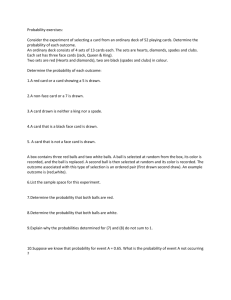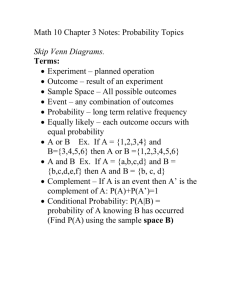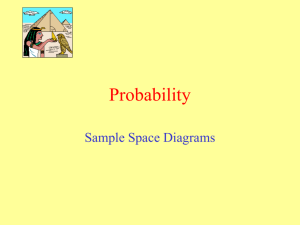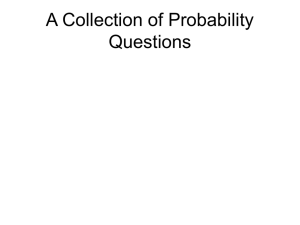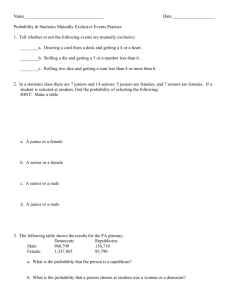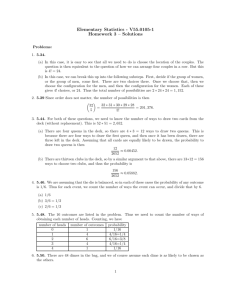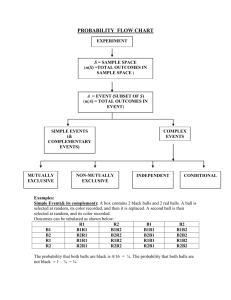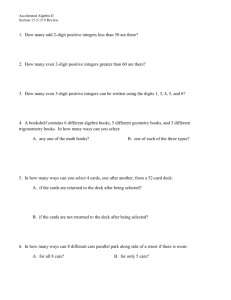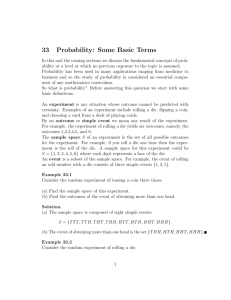3.4 Fundamental and Addition Rule
advertisement
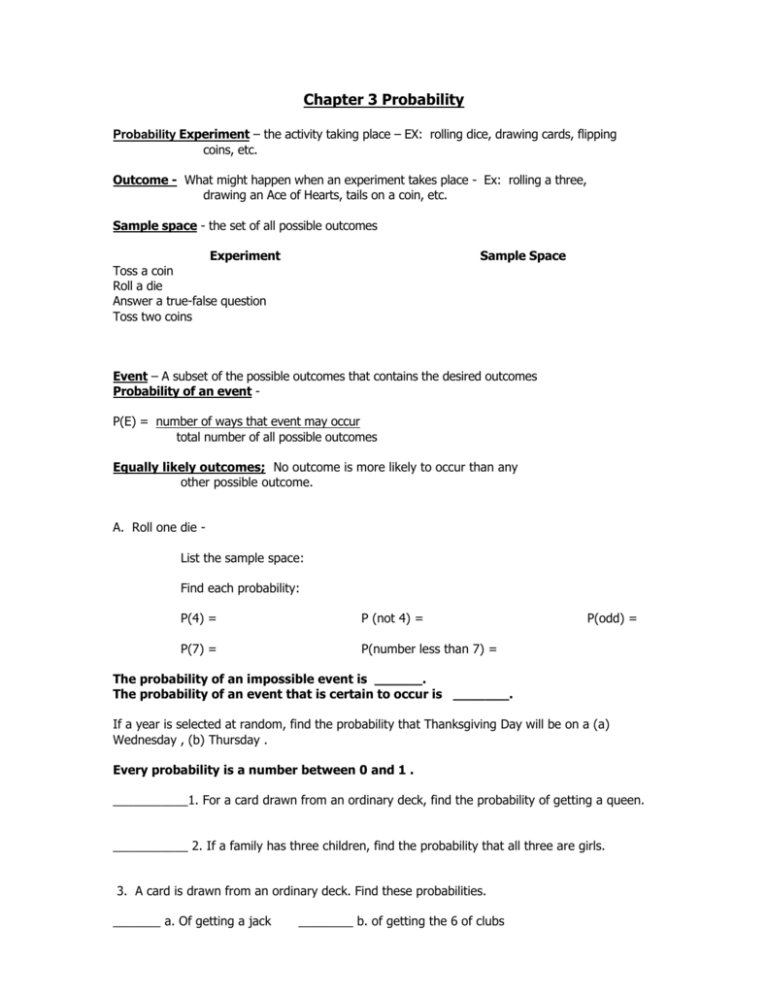
Chapter 3 Probability Probability Experiment – the activity taking place – EX: rolling dice, drawing cards, flipping coins, etc. Outcome - What might happen when an experiment takes place - Ex: rolling a three, drawing an Ace of Hearts, tails on a coin, etc. Sample space - the set of all possible outcomes Experiment Toss a coin Roll a die Answer a true-false question Toss two coins Sample Space Event – A subset of the possible outcomes that contains the desired outcomes Probability of an event P(E) = number of ways that event may occur total number of all possible outcomes Equally likely outcomes; No outcome is more likely to occur than any other possible outcome. A. Roll one die List the sample space: Find each probability: P(4) = P (not 4) = P(7) = P(number less than 7) = P(odd) = The probability of an impossible event is ______. The probability of an event that is certain to occur is _______. If a year is selected at random, find the probability that Thanksgiving Day will be on a (a) Wednesday , (b) Thursday . Every probability is a number between 0 and 1 . ___________1. For a card drawn from an ordinary deck, find the probability of getting a queen. ___________ 2. If a family has three children, find the probability that all three are girls. 3. A card is drawn from an ordinary deck. Find these probabilities. _______ a. Of getting a jack ________ b. of getting the 6 of clubs Empirical Probability Hospital records indicated that maternity patients stayed in the hospital for the number of days shown in the distribution. Number of Days Stayed 3 4 5 6 7 Frequency 15 32 56 19 5 Find these probabilities. a. A patient stayed exactly 5 days c. A patient stayed at most 4 days b. A patient stayed less than 6 days d. A patient stayed at least 5 days Addition Rules for Probability Consider you are at a large political gathering and you select a person at random, and you wish to know if that person is a female or a Republican. There are three possibilities: 1. 2. 3. Consider you wish to know if a person is Republican or Democrat. In this case, there are only two possibilities: 1. 2. Two events are mutually exclusive if they cannot occur at the same time. Determine which events are mutually exclusive and which are not when a single card is drawn from a deck. (A) Getting a 7 and getting a jack. (B) Getting a club and getting a king. (C) Getting a face card and getting an ace. (D) Getting a face card and getting a spade. Mutually exclusive: P( A or B) = P(A) + P(B) 1. A drawer contains three pairs of red socks, two pairs of black socks, and four pairs of brown socks. If a person in a dark room selects a pair of socks, find the probability that the pair will be either black or brown. 2. A day of the week is selected at random. Find the probability that it is a weekend day. Not Mutually exclusive: P(A or B) = P(A) + P(B) - P(A and B) 1. In a hospital unit there are eight nurses and five physicians. Seven nurses and three physicians are female. If a staff person is selected, find the probability that the subject is a nurse or a male. 2. A single card is drawn from a deck. Find the probability that it is a king or a club. P(A or B) = P(event A occurs or event B occurs or they both occur) Use the data in the following table, which summarizes results from the sinking of the Titanic. Survived Died Men 332 1360 Women 318 104 Boys 29 35 Girls 27 18 If one person is randomly selected, find the probability : 1. P(women or a child) = 3. P( a child or someone who survived)= 2. P( a man or someone who survived)= Multiplication Rules for Probability Two events A and B are independent if the probability of A occurring does not affect the probability of B occurring. bg bg Independent Events : P(A and B) = P A P B 1. A coin is flipped and a die is rolled. Find the probability of getting a head on the coin and a 4 on the die. 2. A card is drawn from a deck and replaced; then a second card is drawn. Find the probability of getting a queen and then an ace. 3. An urn contains 3 red balls, 2 blue balls, and 5 white balls. A ball is selected, its color noted, and then it is replaced. A second ball is selected, and its color is noted. Find the probability of each of the following. a. Selecting 2 blue balls. b. Selecting a blue ball and then a white ball. c. Selecting a red ball and then a blue ball. Two events are dependent when the outcome of the first event affects the outcome of the second event. 1. Three cards are drawn from an ordinary deck and not replaced. Find the probability of the following. a. Getting three jacks. b. Getting an ace, a king, and a queen in order. c. Getting a club, a spade, and a heart in order. d. Getting three clubs.
